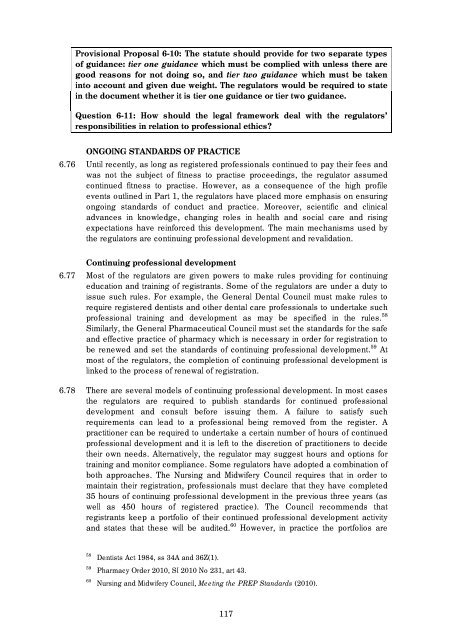Regulation of Health and Social Care Professionals Consultation
Regulation of Health and Social Care Professionals Consultation
Regulation of Health and Social Care Professionals Consultation
You also want an ePaper? Increase the reach of your titles
YUMPU automatically turns print PDFs into web optimized ePapers that Google loves.
Provisional Proposal 6-10: The statute should provide for two separate types<br />
<strong>of</strong> guidance: tier one guidance which must be complied with unless there are<br />
good reasons for not doing so, <strong>and</strong> tier two guidance which must be taken<br />
into account <strong>and</strong> given due weight. The regulators would be required to state<br />
in the document whether it is tier one guidance or tier two guidance.<br />
Question 6-11: How should the legal framework deal with the regulators’<br />
responsibilities in relation to pr<strong>of</strong>essional ethics?<br />
ONGOING STANDARDS OF PRACTICE<br />
6.76 Until recently, as long as registered pr<strong>of</strong>essionals continued to pay their fees <strong>and</strong><br />
was not the subject <strong>of</strong> fitness to practise proceedings, the regulator assumed<br />
continued fitness to practise. However, as a consequence <strong>of</strong> the high pr<strong>of</strong>ile<br />
events outlined in Part 1, the regulators have placed more emphasis on ensuring<br />
ongoing st<strong>and</strong>ards <strong>of</strong> conduct <strong>and</strong> practice. Moreover, scientific <strong>and</strong> clinical<br />
advances in knowledge, changing roles in health <strong>and</strong> social care <strong>and</strong> rising<br />
expectations have reinforced this development. The main mechanisms used by<br />
the regulators are continuing pr<strong>of</strong>essional development <strong>and</strong> revalidation.<br />
Continuing pr<strong>of</strong>essional development<br />
6.77 Most <strong>of</strong> the regulators are given powers to make rules providing for continuing<br />
education <strong>and</strong> training <strong>of</strong> registrants. Some <strong>of</strong> the regulators are under a duty to<br />
issue such rules. For example, the General Dental Council must make rules to<br />
require registered dentists <strong>and</strong> other dental care pr<strong>of</strong>essionals to undertake such<br />
pr<strong>of</strong>essional training <strong>and</strong> development as may be specified in the rules. 58<br />
Similarly, the General Pharmaceutical Council must set the st<strong>and</strong>ards for the safe<br />
<strong>and</strong> effective practice <strong>of</strong> pharmacy which is necessary in order for registration to<br />
be renewed <strong>and</strong> set the st<strong>and</strong>ards <strong>of</strong> continuing pr<strong>of</strong>essional development. 59 At<br />
most <strong>of</strong> the regulators, the completion <strong>of</strong> continuing pr<strong>of</strong>essional development is<br />
linked to the process <strong>of</strong> renewal <strong>of</strong> registration.<br />
6.78 There are several models <strong>of</strong> continuing pr<strong>of</strong>essional development. In most cases<br />
the regulators are required to publish st<strong>and</strong>ards for continued pr<strong>of</strong>essional<br />
development <strong>and</strong> consult before issuing them. A failure to satisfy such<br />
requirements can lead to a pr<strong>of</strong>essional being removed from the register. A<br />
practitioner can be required to undertake a certain number <strong>of</strong> hours <strong>of</strong> continued<br />
pr<strong>of</strong>essional development <strong>and</strong> it is left to the discretion <strong>of</strong> practitioners to decide<br />
their own needs. Alternatively, the regulator may suggest hours <strong>and</strong> options for<br />
training <strong>and</strong> monitor compliance. Some regulators have adopted a combination <strong>of</strong><br />
both approaches. The Nursing <strong>and</strong> Midwifery Council requires that in order to<br />
maintain their registration, pr<strong>of</strong>essionals must declare that they have completed<br />
35 hours <strong>of</strong> continuing pr<strong>of</strong>essional development in the previous three years (as<br />
well as 450 hours <strong>of</strong> registered practice). The Council recommends that<br />
registrants keep a portfolio <strong>of</strong> their continued pr<strong>of</strong>essional development activity<br />
<strong>and</strong> states that these will be audited. 60 However, in practice the portfolios are<br />
58 Dentists Act 1984, ss 34A <strong>and</strong> 36Z(1).<br />
59 Pharmacy Order 2010, SI 2010 No 231, art 43.<br />
60 Nursing <strong>and</strong> Midwifery Council, Meeting the PREP St<strong>and</strong>ards (2010).<br />
117
















